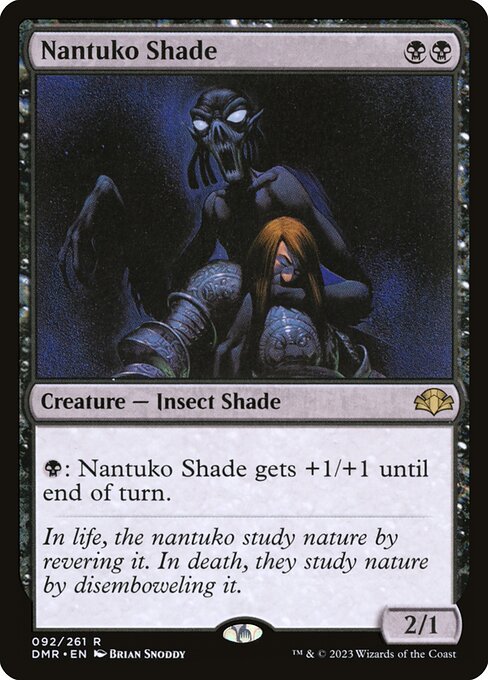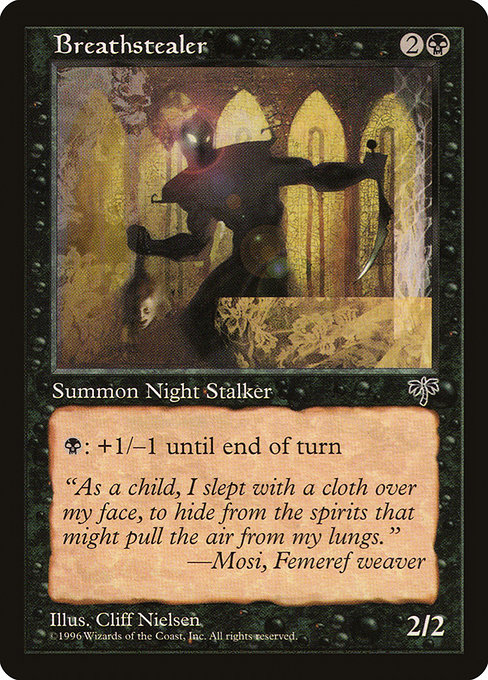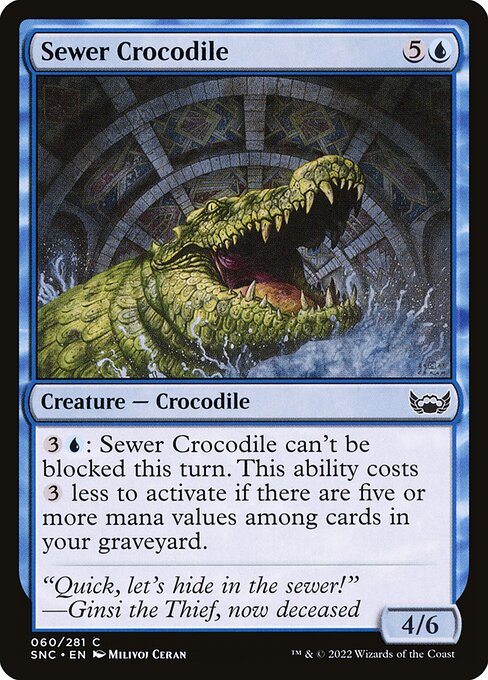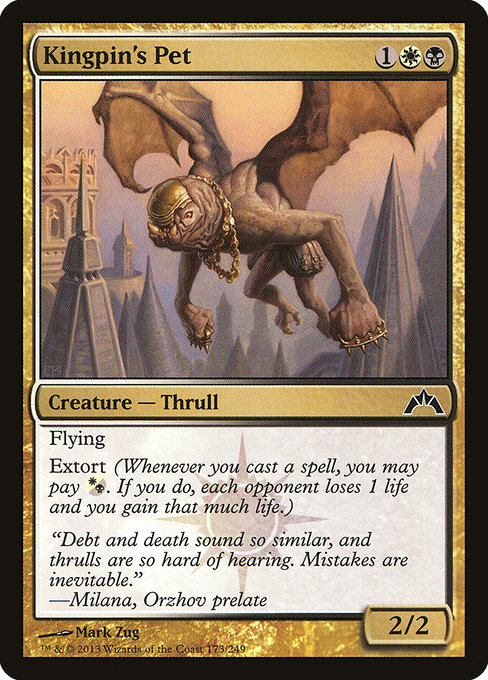Cover image: Abomination by Mark Tedin
Content note: we’re diving deep into horror territory today, so if you don’t want to see imagery of gore, surgery, physical mutilation, decay/zombies, or other horror creatures, you may want to skip this for now. Also, if you hover over a card in the first paragraph—specifically Cosmic Horror—you’ll see a reference to sexual assault in the title of a famous poem, so forewarning on that.
You probably remember the first Magic: The Gathering card that gave you the creeps. For some, it was Necrite, or Macabre Waltz, or Pulling Teeth. For me, it was Legends’ Abomination, whose translucent, waxy flesh hit me in the same way as the Fluke-Man from The X-Files did during the same time period.

Necrite by Ron Spencer
Early Magic was phenomenal at providing portraits from Hell, with cards like The Wretched, The Fallen, and Cosmic Horror passed around the schoolyard like the video from Ringu. There was something about the static nature of these cards, captured as they were in pigment and frozen in time, and the stylized artwork that was more impactful to young me than the gorier, gnarlier cards like Ashen Ghoul.
Gaze of Pain, Morgue Thrull, Nettletooth Djinn—these cards were scary the first time and the hundredth because they simply didn’t ever change. Horror that you can’t look away from is bad, but what’s worse is horror that never looks away from you.

Macabre Waltz by Jim Murray
Personally, I loved it. I was a horror kid, particularly happy in the intersection of horror and folklore. Where other seven-year-olds were memorizing facts about dinosaurs, I was memorizing myths about cryptids. Other kids loved the giant squid; I loved the kraken. I was obsessed with horror movies my parents refused to let me see (they were, of course, correct), from Hellraiser to The People Under the Stairs. I pored over Leonard Maltin books and encyclopedias, scouring sources for the edgy and avant-garde; I was the only ten-year-old in 1996 suburban South Carolina who knew the word “giallo,” although I had never seen one or even knew how to pronounce the word.
A Black mage since day one, I traded at a disadvantage to collect every Zombie, Specter, and Horror I could get my hands on; I was happier losing with Flesh Reaver than winning with Serra Angel. That was an interesting era; the Satanic Panic hangover meant that Wizards had to shy away from depicting demons and pentagrams, but could print the most gruesome art as long as it was called a Horror. Unholy Strength lost its pentagram, yet Reclusive Wight and Brain Maggot were fair game.

Pulling Teeth by Jim Pavelec
Magic continues to embrace horror, to its lasting credit, with Innistrad a popular plane and the next year of cards dedicated to Phyrexians, in all their goop-and-gears glory. In honor of that, and of today’s date, we’re going to delve into the most horrific creature types in Magic that go beyond the standard archetypes—certainly, Vampires, Zombies, Skeletons, and Werewolves are scary conceptually, but they’ve become staples of the game, been a bit defanged by becoming old friends and tournament-winning decks. They’re the Universal horror monsters who became tropes of American fiction—the stuff of Halloween yard decor, and not of nightmares.
There’s a whole menagerie of terrifying creatures in Magic’s margins, some of which are completely unique to the game, and these five are the ones that go beyond the tropes of ghouls and ghosts to something uniquely horrific.
Shade
Shades have been around since Alpha’s Frozen Shade. Mechanically, Shades are overcosted creatures who trade a high casting cost for the ability to grow larger temporarily for further mana investment, often leading to extremely unappealing cards like Undercity Shade and Nightwing Shade. Shades have generally never been playable in Constructed for that reason, but one is quite an exception: former Standard powerhouse Nantuko Shade.

The centerpiece of the Odyssey-Onslaught era Mono-Black Control deck, with its Cabal Coffers and Mutilates, the Shade was above the curve on turn two and it dominated as the game wore on. (Seriously—it was quite a break with tradition to give Black a two-mana 2/1 back then, let alone one with a cost-effective ability.) Its return in M2011 was much-heralded but, like other former staples before it, it never did much in a higher-powered environment. In the clear light of day, shades fade.
The spectral equivalent of a Lich, Shades retain their memories and malice, but grow powerful in death. Shades draw on darkness to grow, which connects to some deep dread of the dark in our brains: Darkling Stalker has long been one of my favorite pieces of Magic art, and Dungeon Shade is terrifying—your eyes can barely grasp what they’re seeing, but the overall impression is horrific. Shades are vengeful, clinging ghosts who haunt the darkest moors and dankest mausoleums, and Magic’s Shades have a distinct identity beyond a Spirit or a Specter.
Scarecrow
Another creature type that dates almost back to the start of the game, Magic’s first Scarecrow was printed in The Dark before the creature type disappeared for over a decade.

It came back with a vengeance in Shadowmoor, though, with the Reaper King as the leader of a newly revitalized tribe. Shadowmoor’s Scarecrows were mechanically tied to the set’s mutable color combinations and served as Limited linchpins: Pili-Pala, Scuttlemutt. But the aesthetic was what made the tribe so appealing—like the British-influenced plane itself, it was whimsical and threatening in equal measure. Tattered scraps and bones lashed to wicker and wrapped in rawhide, animated by alien magic, the Shadowmoor scarecrows are sinister and distressingly organic—more Scary Stories to Tell in the Dark’s Harold than Frank L. Baum.
Scarecrows have returned in Eldraine and Innistrad and Unfinity (and presumably there’s a sneaky return to Shadowmoor in Modern Horizons’ Farmstead Gleaner, with its untap symbol)—basically anywhere that needs a touch of macabre artifice. They could easily fall under the broad umbrella of “Construct,” but Wizards chose to break them into their own separate, eerie category, and those of us who hold out hope for the Reaper King as an eventual Commander contender are grateful.
Nightstalker
The history of Nightstalker is brief but interesting—first printed in Legends as a one-of in Shimian Night Stalker, Mirage brought us more “Night Stalkers” in Breathstealer, Feral Shadow, and Urborg Panther.

The three Jamuraan Night Stalkers are vastly different in form, but team up to “cheat” out a Spirit of the Night. I say cheat in quotes because, by the time you’ve cast the three overcosted creatures and sacrificed them, you could have just cast Spirit of the Night, although you can split the cost up over several turns rather than the nocturnal avatar’s punitive nine mana. We next saw Nightstalkers, minus the space, as Black’s tribe in Portal Second Age, where they were a sentient race of bog-dwelling sadists.
Mechanically, they had your standard Black control vibe and mostly reskins of pre-existing cards—but artistically, they were unique. Nightstalkers are angular and spined, with elongated faces and long limbs, both feral and whimsical. There’s something of the boogeyman about them; they look like predators and tricksters, both human-like and very alien and all bogpunk.
We haven’t returned to Nightstalkers since Prophecy, and I don’t have high hopes, since they seem to be a Dominarian race. But for such a limited creature type, they certainly have had an impact. Breathstealer may just be a mediocre Gray Ogre, but that art is the sort of thing that sticks with you—especially coupled with the flavor text, which perfectly ties into the fears and superstitions of childhood. “Jamuraan children hide under blankets just like you,” it implies. “So if they’re scared of Breathstealers, shouldn’t you be?”
Crocodile
This is included as a confession: I’m terrified of and fascinated by alligators. I find them atavistically loathsome and also terribly compelling. I track news about them, watch videos of them hunting and strolling across human spaces and avoiding other predators.
Part of this fear is logical: as a resident of South Carolina and a frequent visitor of its swamps and marshes, I’ve come across alligators in the wild and they, unlike other major predators, do actually attack humans with some regularity. They’re implacable, alien, and perfectly adapted for their evolutionary niche, and they don’t have the same fear of human settlements that many major predators do, which is to say: while alligator attacks are still quite rare, the beasts themselves are not a rare sight in the SC lowcountry, wandering across parking lots and golf courses and, in one memorable instance, my niece’s kindergarten playground.
Last month, local hunters shot a massive gator in Lake Marion, whose 625-pound (283 kg) bulk didn’t even come close to the record monster culled from Lake Moultrie back in 2010, which topped the scales at 1,025 pounds (465 kg). Imagine that: when you enter our lakes, you share the water with a predator the size of a sedan. Magic’s alligators, gharials, caimans, and crocodiles are all collected under the “Crocodile” creature type, which is fair, since in the real world they’re all grouped under the Crocodilia order, which takes its name from the Greek for “stone/shingle worm.”

Ravnica’s undercity is rife with alligators in a very amusing nod to the old urban legend of flushed alligators breeding in New York sewers, so many of our crocodilian representatives are found on that plane. A fair amount show up on Tarkir as Sultai waste disposal and punishment solutions and on Amonkhet as a nod to the crocodile’s importance to the Egyptian cosmology. They turn up on Mirrodin (Dross Crocodile) and Zendikar (Hagra Crocodile) and even on the sunnier, cosmopolitan planes of Kaladesh (Dukhara Scavenger) and Strixhaven (Moldering Karok). There’s no escape from these scaly swamp behemoths, whether you’re in Charleston or New Benalia, and that’s the real horror.
Thrulls
One of Magic’s unique creature types, the Thrull came about in Fallen Empires. The basics are: as Dominaria headed towards an ice age, the consequent scarcity and seasonal disruption led to desperate civilizations taking drastic measures. In Sarpadia, the setting for Fallen Empires, the necromancer Endrek Sahr, Master Breeder imbued dead flesh with a temporary, attenuated form of life, creating a race of necromantic servants called Thrulls.
These Thrulls were impressed into warfare, exploited as mana sources (Basal Thrull), and harvested for their body parts (Armor Thrull), before rebelling against the ruling class and their creators. A counterinsurgency, led by Jherana Rure, fought back the Thrull armies, but specialized assassin Thrulls killed Rure. Thrulls overran the Sarpadian Empires, eventually spreading in smaller numbers to the rest of Dominaria. Thrulls have also been spotted on Rath and Phyrexia, where they serve a similar purpose as sacrificial chumps and mana repositories (Blood Pet, Blood Vassal).

Thrulls returned in Ravnica, where the Orzhov create Thrulls from flesh sloughed off from their ascendant patriarchs, and remain as an exploited underclass in the city plane. With rudimentary intelligence, mutated bodies, and a short lifespan, Thrulls are pitiable and pathetic, but also incredibly disgusting. I love that dynamic. Morphologically, they’re all over the map, from wizened little gnomes like Morgue Thrull to gargoyles like Kingpin’s Pet to beefy centaurs like Derelor.
That’s the beauty of Thrulls: stylistically, they can be anything, so long as the art is close to “nasty little wretch.” Thrulls force us to confront our ephemerality and our attitudes about factory farming and class warfare, and they do so by depicting awful little creatures that let Magic’s artists go hogwild—the absolute best we can hope for from the game.
There are other horrific tribes in Magic’s history, of course, from the recently-official Phyrexian creature type, which was added to dozens of Zombies, Horrors, Germs, and Constructs from the last three decades, to the Demon type, which returned with great fanfare in 2002 with Onslaught’s Grinning Demon and has become as commonplace and celebrated as Dragons and Angels.
Alpha gave us the existential horror of Gloom, the epidemiological horror of Pestilence, the ghostly horror of Bog Wraith, and Wizards hasn’t stopped pumping out chilling glimpses of a supernatural world since. From the body horror/forced mutation of the Phyrexians to the exploitative necromantic practices of the Sultai to the warped predatory ecosystem of Rath, horror has been a part of the game since day one. Magic’s aesthetics and priorities may have shifted over the decades, but it’s clear there will always be horror in Magic. Now it’s up to us to find the magic in horror.
Rob Bockman (he/him) is a native of South Carolina who has been playing Magic since Tempest block. A writer of fiction and stage plays, he loves the emergent comedy of Magic and the drama of high-level play. He’s been a Golgari player since before that had a name and is never happier than when he’s able to say “Overgrown Tomb into Thoughtseize,” no matter the format.

